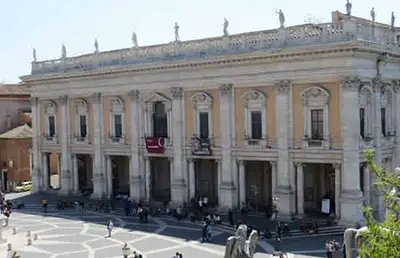Most of the artistic features of the Palazzo dei Conservatori are neither independent nor dependent on one artistic generational style.
Michelangelo was tasked with bringing the entire Capitoline Hill from a state of derelict and thus made his designs for every particular building and the Piazza bearing in mind what artistic or structural significance other structures of the Capitoline had or played.
For the sake of discussing all that Michelangelo had in mind when working on the Palazzo dei Conservatori, it is crucial to have a few historical facts at the fingertips.
The Rise and Fall of the Roman Empire
Through the rise and fall of the Roman Empire in the one thousand years that the Romans had hegemony in close to the whole world, the Capitoline Hill served as the locale of power. It was the epicentre of all the might and the steadfast grip that the Romans had in the world: not in entirety but in a façade of generality.
Rome came to a civil war and tragedy as precarious events occurred to prominent personalities who came to tragic demises. By the onset of the Renaissance period, Julius Caesar had been stabbed to death in the Senate, and bureaucratic wars had besieged the Capitoline Hill which drifted from its symbolic importance to an untidy execution site. In a bid to reinstate the Zenith of Roman Rule from the gradual decline the papal structures were subjecting it to by blotting it and enervating the Capitol Hill, Emperor Charles V decided to visit Rome. Pope Paul III Farnese contracted Michelangelo to rejuvenate the glory of the Piazza del Campidoglio to save face and perhaps avoid bad politics. It is important to note that though Michelangelo did not oversee the complete overhaul of the pillaged state of the symbolic garden and buildings, his very design and plan for the Piazza del Campidoglio is profoundly present in the modernized structures.
Michelangelo’s work on Palazzo dei Conservatori
Michelangelo transformed the Palazzo dei Conservatori by redesigning its façade to implore glory and glamour out of the ancient and modern visitors of Rome. He first added a few robust Corinthian pilaster strips. He placed them on high pedestals and then incorporated gigantic pillars to accentuate the feel of power and stability. He went further to wow all and sundry by constructing the Palazzo Nuovo just opposite it from ground up. Though it was a building by its own right, art critics view it as an adornment for the Palazzo dei Conservatori as it is its exact replica from the front: a mirror image of the initial and historic building. Modern architects describe the two buildings, Palazzo dei Conservatori and Palazzo Nuovo as identical in design and dimensions: something which is near impossible to achieve.
How so much art?
The significance of the Palazzo dei Conservatori dates from ancient Roman history. The building which stands on the right side of the Piazza del Campidoglio was initially constructed to serve as a palace for conservators. Conservators were state officials who along with the Senate, administered Rome as magistrates. It stood on the very ground that once served as the foundation for the temple of Jupiter.
As part of the Capitoline Museums, the building, after its refurbishment by Michelangelo, hosts some of the most expensive and symbolic art forms from various historic ages like the antiquity, the medieval ages and the Renaissance Period. Most of the art was donated by Pope Sixtus IV, the majority of which were ancient bronze relics Roman, Greek and Egypt in decent and design.
Sculptures that Palazzo dei Conservatori is famous for
Most of the sculpture collections here hail from Rome, Greece, and Egypt. The exquisite honorary monument adorns the main staircase to Emperor Marcus Aurelius. The monument was made in sheer bronze and was fabricated in honour of the Roman Emperor Marcus Aurelius. Michelangelo knew it would have been melted at first sight and that the Catholic Church could have reprimanded him and thus led people to think it was for the honour of Christian Emperor Constantine. It was allowed to stand at the centre of the square gardens until 1981 when it was taken into the Palazzo dei Conservatori for preservation and was replaced by a replica.
The second floor features the magistrates’ apartment and installed by fine interior artistic impressions like carved surfaces like ceilings and tapestries. It also houses an emblem of Rome, the bronze sculpture of a she-wolf nursing the twins Romulus and Remus.
The third floor acts as the functional museum of the museum building. It holds in it the Capitoline Art Gallery and houses most the museum’s art galleries. Visitors on the third floor are treated to sight of the Capitoline Coin Cabinet, numerous applied art crafts, medals, authentic and antiquated jewels and jewellery.
Other attractive features of Palazzo dei Conservatori
When of Michelangelo or not and whether of Renaissance or not, one of the Palazzo dei Conservatori most thrilling visits includes the New wing that features a great glass covered hall. The over glass-covered hall is of Michelangelo design as it replicates the design of the Piazza. The Marcus Aurelius sculpture that was initially installed in the piazza under Michelangelo’s directive acts as the hall’s centrepiece, and it is a magnificent sight to behold. Its history accentuates the grandiose feel of the hall making it a phenomenal place for tourists to visit.
Beneath the Palazzo dei Conservatori, visitors of the museum are treated to an underground art exhibition. Famous as Galleria Congiunzione, the gallery links all the three buildings of the piazza and hosts the ruins of early centuries of Roman inhabitation. The underground gallery successfully endeavours to put visitors in a nostalgic mood.
In the profound nature of the Renaissance Architecture, Palazzo dei Conservatori truly epitomizes the very best that the Renaissance architecture had to offer. And it was so good that it continues to marvel the whole world attracting millions of international tourist to travel to Rome just to see it.


